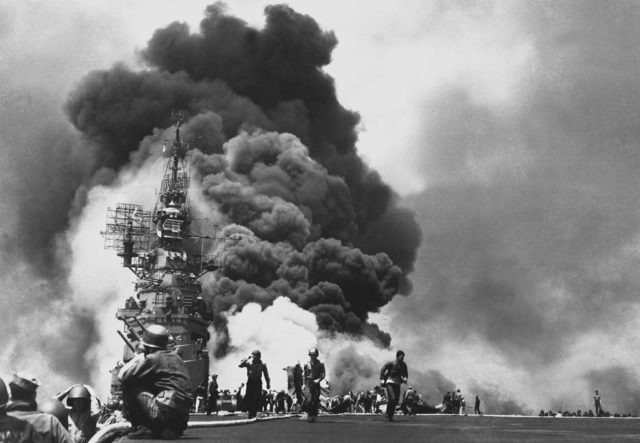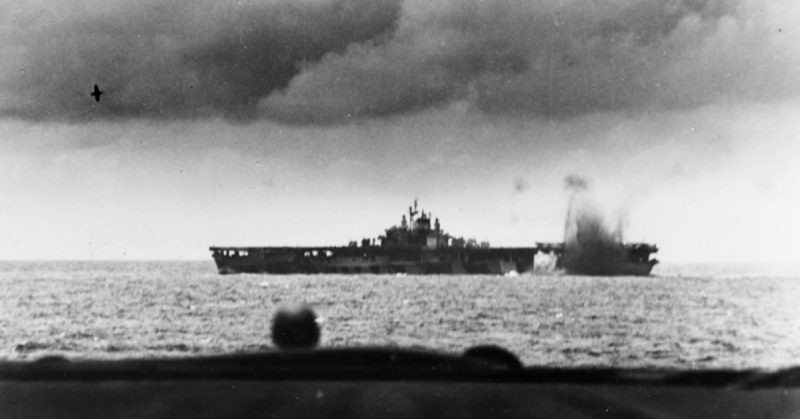War History Online proudly presents this guest article by Ryan Kim
On the morning of May 11, 1945, the USS Bunker Hill (CV-17) was supporting the invasion of Okinawa from a hundred kilometers away. The crew was relatively relaxed and carried out their duties as usual.
At 1004, US planes on patrol sighted two Japanese Zero planes headed for the Bunker Hill. The first released a 550-lb bomb which penetrated the flight deck but failed to do any significant damage, coming out the other side and exploding above the ocean. The fighter aircraft crashed into the ship and destroyed nearly all the planes on deck igniting their fuel and causing a large fire.
The other plane was a different story. Its bomb penetrated the flight deck nearly at a vertical angle and detonated in the hangar deck. The pilot then crashed into the Bunker Hill near its island superstructure. As a result, nearly 400 were killed, and almost 300 were injured.
It is but one of many examples used in the Imperial Japanese war ethic. The soldiers were immensely disciplined; willing to give up their lives for their Emperor – often in flames and explosions. That discipline, however, ultimately contributed to their demise.
The Japanese war ethic and discipline were admirable to both friend and foe; the tale of a Japanese soldier leaving his family for certain death was not uncommon. Many of their suicidal endeavors and attacks were successful, but nowhere near enough to win the war.
The most obvious example of their discipline was the kamikaze: Pilots who used their aircraft, not as fighters or bombers, but as missiles, loading explosives and fuel onto them and stripping away any non-essentials. It produced better accuracy and a larger payload. The objective was to destroy or disable, American ships.

The strategy sometimes worked, as it did with the Bunker Hill, but in only around 11% (which dropped to 8%) of the time. It is an appalling number in comparison to dive bombers, which succeeded in their attacks more than half of the time, achieving 59% in the attack on Pearl Harbor, and 53% in the Battle of the Coral Sea.
With kamikaze attacks, the Japanese were doing little more than throwing away the experienced pilots they had along with their remaining planes. A similar idea was deployed with the Kaiten torpedo, a manned torpedo used in the final stages of the war.
Another example of their ethic was the suicidal “banzai charge,” where a wave of Japanese soldiers mounted a large scale assault against their enemy, often with the cry of “Tennōheika Banzai!” or “Long Live the Emperor!” The biggest banzai charge was during the Battle of Saipan, where US Infantry lost almost two battalions, with 600 men dead. The cost to the Japanese was 4,300 soldiers – a 1:14 trade-off. During WWII, many Japanese commanders forbid the maneuver, aware of its futility.
On a rather larger scale, the sacrifice of experienced soldiers was a repeating pattern in Imperial Japanese warfare, regardless of however pointless. In its final battle, the crew of the aircraft carrier Zuikaku stayed on board saluting their flag in a last “Banzai” rather than attempting escape or evacuation. The resulting casualties were 843 men out of 1,600. The survivors were rescued by the nearby destroyers Wakatsuki and Kuwa.
In the final stages of WWII, the last major Japanese naval offensive, Operation Ten-Go (Heaven One) was planned. The operation entailed certain death for those involved. 10 Japanese warships – including one single battleship the legendary Yamato – against nearly 60 US Navy vessels. In line with their suicidal mettle, the operation was regardless carried out, with almost all the Japanese ships being sunk (including the Yamato) and barely any damage being done to the American ships.
Japanese incompetence was a consequence of having few experienced forces and was painfully evident throughout the entirety of the war. The Battle of Midway, for example, was lost as a result of the Japanese destroyer Arashi failing to hide its wake while attempting to rejoin the main fleet from hunting the USS Nautilus. The “indestructible” aircraft carrier, Taihō, sank from a single torpedo, mostly due to design flaws and poor damage control by the crew. The greatest Japanese commanders were often ignored, such as Yamamoto’s strategies and planning.
Due to their war ethic, Japan threw away valuable resources and personnel for small temporary victories which made them blind to the future, where the long term effects took place. By the end of WWII, Japan barely had any assets left, other than a few attacks being carried out, such as the tragedy of the USS Indianapolis by the submarine I-58.
Some people say their code of honor was disgusting and should not be revered. Some may say that it was truly something to be admired and sought after. Ultimately, however, it lost Japan the war. They sacrificed resources and people, and their ethics led to the bombings of Hiroshima and Nagasaki in August of 1945.
By Ryan Kim
